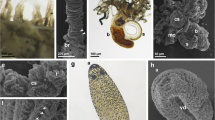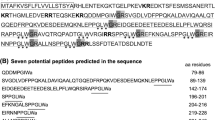Abstract
The metamorphosis of many marine invertebrate larvae is induced by environmental signals. Upon reception of the cues, internal signals have to be set in motion to convey information to all cells of the larvae. For hydrozoan larvae it was hypothesised that ectodermal neurosensory cells at the anterior part are those cells receptive of the inducer. Recently, it was shown that novel peptides with a common GLWamide terminus are found in Cnidaria. These peptides are located in a specific subset of the anterior sensory cells. It was hypothesised that the neuropeptides represent an internal signal coordinating the metamorphic process. In the current study we present further evidence for this hypothesis. Induction of metamorphosis is very specific for the GLWamide terminus and amidation is essential. The potency to metamorphose is strongly correlated with the presence of GLWamide-immunoreactive cell bodies. Our data fit our hypothesis about a very important role of GLWamides in the initiation of the morphogenetic processes very well.
Similar content being viewed by others
Author information
Authors and Affiliations
Additional information
Received: 16 February 1998 / Accepted: 11 April 1998
Rights and permissions
About this article
Cite this article
Schmich, J., Trepel, S. & Leitz, T. The role of GLWamides in metamorphosis of Hydractinia echinata . Dev Gene Evol 208, 267–273 (1998). https://doi.org/10.1007/s004270050181
Issue Date:
DOI: https://doi.org/10.1007/s004270050181




